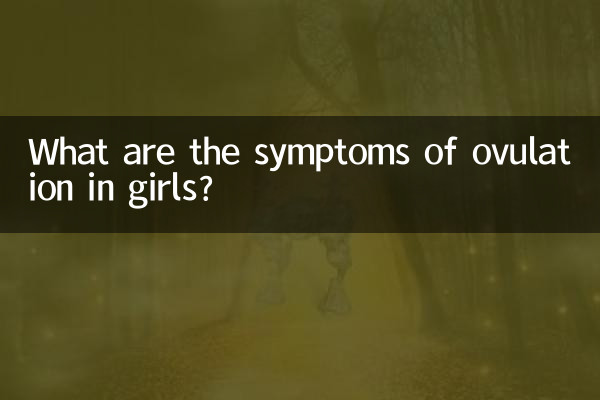What are the symptoms of ovulation in girls?
Ovulation is an important stage in a woman's menstrual cycle, usually occurring in the middle of the menstrual cycle (around day 14). Understanding the performance of ovulation can help women better understand their own health status, which is of great significance whether it is preparing for pregnancy or contraception. The following is structured content about girls’ ovulation performance that has been a hot topic on the Internet in the past 10 days.
1. Physiological manifestations of ovulation

During ovulation, a woman’s body will undergo a series of changes. The following are common physiological manifestations:
| Performance | Detailed description |
|---|---|
| Increased basal body temperature | After ovulation, luteinizing hormone (LH) increases, causing body temperature to rise by 0.3-0.5°C |
| cervical mucus changes | Increased secretion, transparent egg white shape, strong stringiness |
| Mild pain in lower abdomen | Some women will feel a brief stabbing pain in one side of their lower abdomen (ovulation pain) |
| breast tenderness | Hormonal changes may cause breast sensitivity or tenderness |
2. Emotional and behavioral changes during ovulation
In addition to physiological manifestations, ovulation may also affect a woman’s mood and behavior:
| Performance | Detailed description |
|---|---|
| Increased libido | Elevated estrogen levels may increase sex drive |
| mood swings | Some women may feel more excited or irritable |
| High energy | Hormone changes may bring temporary energy boost |
3. How to accurately determine the ovulation period?
In order to grasp the ovulation period more accurately, you can combine the following methods:
| method | illustrate |
|---|---|
| Ovulation test strips | Detect the peak value of LH hormone in urine to predict ovulation time |
| B-ultrasound monitoring | Observe follicle development through ultrasound |
| body temperature recording method | Continuously measure basal body temperature and observe the rise in temperature after ovulation |
| menstrual cycle calculation | Suitable for women with regular menstruation (with a 28-day cycle, ovulation usually occurs on the 14th day) |
4. Be wary of abnormal symptoms during ovulation
If the following abnormalities occur, it is recommended to seek medical treatment in time:
| abnormal behavior | Possible reasons |
|---|---|
| severe abdominal pain | Rupture of ovarian cyst or corpus luteum hemorrhage |
| abnormal bleeding | Hormone imbalance or gynecological disease |
| Continuous high temperature without fluctuation | May indicate abnormal luteal function |
5. Popular questions and answers on the Internet: Frequently asked questions about ovulation
Combined with the search data of the past 10 days, the following are the ovulation-related issues that women are most concerned about:
| question | answer |
|---|---|
| Will I definitely get pregnant during ovulation? | The probability of pregnancy is high, but the successful combination of sperm and egg is required |
| Are anovulatory symptoms normal? | Some women’s symptoms are not obvious and need to be judged with other methods. |
| What to do if you have bleeding during ovulation? | Small amounts of bleeding usually require no treatment, but continued bleeding requires medical attention. |
Summarize
The symptoms of ovulation in girls vary from person to person, but usually include physiological signals such as changes in body temperature, increased secretions, mild abdominal pain, as well as fluctuations in mood and sexual desire. Through scientific monitoring (such as test strips, B-ultrasound), the ovulation time can be grasped more accurately. If abnormal symptoms occur, you should consult your doctor promptly. Understanding this knowledge can help women better manage their health and fertility plans.

check the details

check the details